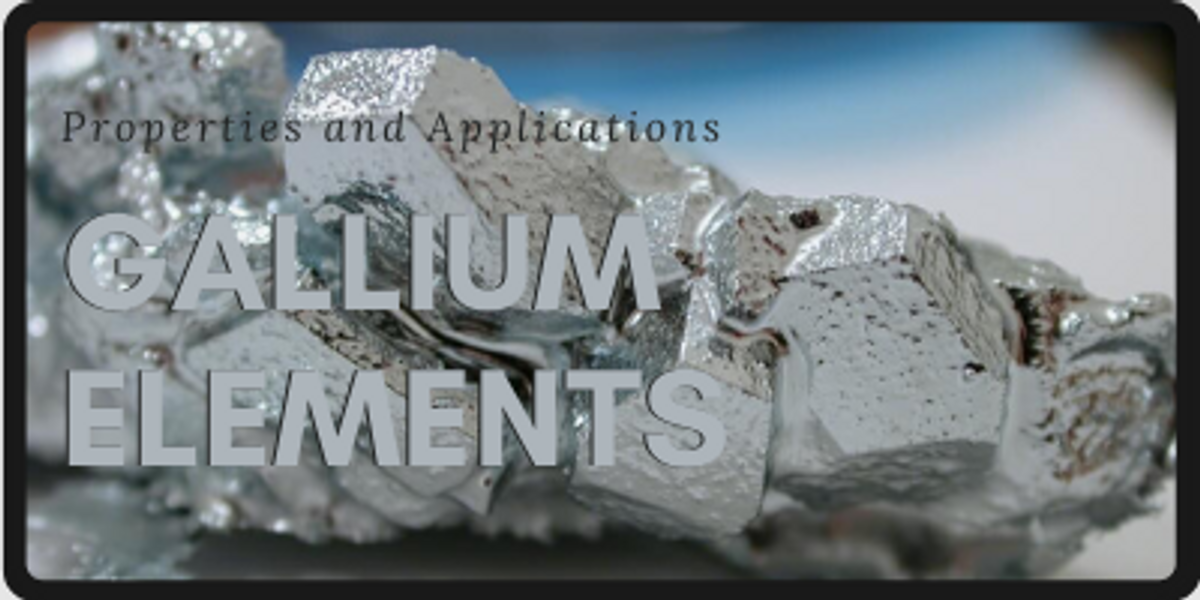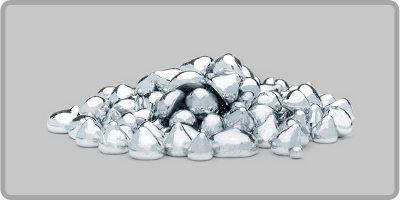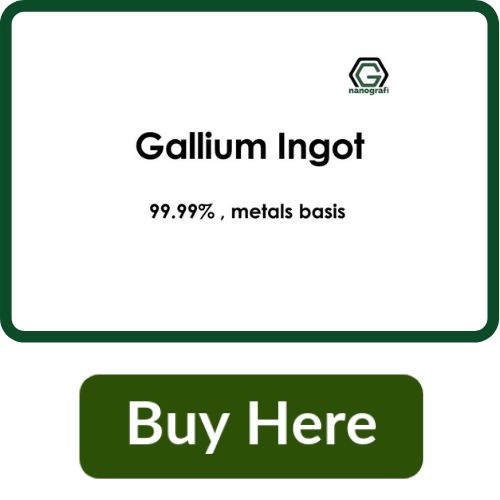Gallium Specifications and Applications - Nanografi Blog
Gallium with the atomic number and weight of 31 and 69.7 respectively, is a chemical element belonging to group thirteen of the periodic table along with aluminum, indium and thallium. At the standard temperature and pressure defined by IUPAC (0˚C and 100 kPa), gallium is a soft metal with a slivery blue hue but it seems like a liquid slivery white metal at temperatures over 29˚C. Metallic gallium suffers fracture if too much pressure is applied on it. Even though gallium doesn’t occur as a free unbound element in nature, it is found as trivalent gallium compounds bauxite (a rock with huge amount of aluminum) and in zinc ores. Over 95 percent of gallium has applications in commercial semiconductors.
Physical Properties of Gallium
Gallium’s melting and boiling points of 29.9 and 2400˚C, respectively. Due its specific behavior as a liquid metal at lower temperatures, gallium is employed as a temperature reference point by set by the International Bureau of Weights and Measures (IBWM) in the International Temperature Scale (ITS) and therefore, it can be used in thermometers instead of mercury considering its environmentally friendly and non-toxic nature. Gallium’s liquid nature makes it possible for that to cool down so perfectly below its melting point (29˚C) that its nanostructured form, gallium nanoparticles, can be stored in its liquid state at -183˚C with applications in cryogenics 1. With regard to its thermal behavior, gallium is categorized among the three other metals (Rubidium, Cesium and Mercury) as a non-radioactive liquid metal at lower temperatures. Unlike the three metals mentioned above, however, gallium isn’t either highly toxic or reactive making it a potential and agent to be applied in thermometers. Above this, gallium has a considerably wide temperature window in its liquid state with a low vapor pressure at higher temperatures. Gallium has strong anisotropic properties with clearly different values along the three x, y, and z axes generating significant difference in thermal expansion coefficient. The fact is the physical properties of gallium highly and closely depend on its thermal behavior as the thermal expansion coefficient increases considerably by melting. An important point in storing gallium is that the liquid state of gallium has 3.10 percent expansion and shouldn’t be stored in metal and glass container. In its liquid form, gallium has a high density like plutonium, bismuth, germanium, antimony and silicon.

Gallium Isotopes
So far, some 31 isotopes of gallium have been discovered with their masses ranging from 56 to 89 among which there are only two stable isotopes as 69Gallium (as the most abundant) and 71Gallium. Other gallium isotopes are radioactive like 67gallium with the longest half-life of 3.261 days. Gallium isotopes with lighter atomic weight than 69 suffer decay through emitting beta ray (positron or positive electron) and electron capture to convert to zinc. In the case of isotopes heavier than 69gallium such as 71gallium, the isotope decays through emitting minus beta ray with consecutive neutron emission to convert to germanium isotopes. Among the radioactive gallium isotopes, only 67gallium and 68gallium have applications in nuclear medicine 2.
Chemical Properties of Gallium
Gallium engages in reactions as a trivalent metal with three oxidation states. The (+1) oxidation state is rare and with inorganic compounds like Ga2O and very unstable GaCl3. Gallium (II) compounds are dioxan complex with the molecular formula of Ga2Cl4(C4H8O2)2 and GaS. Gallium is dissolved in strong acids such as sulfuric and nitric acids forming the (+3) oxidation state as gallium sulfate and gallium nitrate. Gallium has no reaction in water and the atmosphere since it normally forms a protective oxidized layer and most gallium salts occur as their hydrated form. It should be noted that gallium reacts with hydrogen at higher temperatures. Gallium can diffuse into the lattice of other metals steel and aluminum-zinc alloy causing them to lose their strength and rigidity and become brittle.

Gallium Preparation and Applications
As it was mentioned earlier, elemental gallium doesn’t occur naturally and can be processed to obtain through smelting. Ultrapure gallium seems slivery blue and can bear fracture like glass. There has been a steady increase in world gallium production in the past two decades. To prepare it, gallium nitrate and aluminum nitrate are mixed and then it is extracted as a gallium (III) oxide through removing aluminum nitrate with consecutive processing by nitrogen oxide to obtain the metallic gallium. The most notable application of gallium is in semiconductor production industry as material to dope silicone computer chips and manufacturing III-V type semiconductors namely gallium arsenide. Its radioactive isotopes (67Ga) is substantially applied to treat receptor-based non-oncological diseases including sarcoidosis and infections as well as for argon gas screening. It has been proved that the absorption of 67Ga into tumor cells is stimulated by hypoxia of tumor cell transferrin receptors. Gallium nitrate has also been used an antitumor agent to suppress tumors in the lymphatic system and bladder.
Click Image to Learn More About Gallium
It has also been discovered that gallium can trigger apoptosis through activating the caspase system and affects hypercalcemia which is associated with number cancers 3. In addition, lasers made of GaAs (gallium arsenide) have operation wavelength of 904nm and are used in treating myofascial syndrome (a chronic pain disorder) and bone formation. For the moment no biological role has been found to associate with gallium in nature. Despite the fact that gallium has no biological function, gallium ions act similar to iron (III) salts in biological systems. It has been known that gallium involves in inflammatory responses and serves like a marker for many disorder conditions. Some gallium salts have applications in pharmaceutics and radiopharmaceutics as well. The interest in gallium’s role as an anticancer agent increased when gallium (III) citrate was injected to tumor cells in animals suppressing them. Additionally, gallium nitrate has been shown to have antineoplastic activity.
Gallium has been applied in alloys which need to have low melting points. It is extensively used electronics taking the advantage of its compound called gallium arsenide. This chemical gallium compound has applications in high-speed switching circuits, microwave circuits and infrared circuits. Indium gallium nitride and gallium nitride have semiconducting properties and emit violet and blue lights are used in light emitting diodes (LEDs) and diode lasers. GaN is another compound of gallium which is used in electronics too. In jewelry, gallium is used to produce artificial gadolinium gallium garnet.
Gallium with its unique properties of being a liquid metal at lower temperatures and very little toxicity has found a wide range of applications in industries, electronics, biology and science. It is used in thermometers instead of hazardous mercury and has applications in semiconductors and alloy making industries. Gallium compounds also serve as anticancer agents and pharmaceutics.
References
1. Parravicini, G. B. et al. Extreme undercooling (down to 90 K) of liquid metal nanoparticles. Appl. Phys. Lett. 89, 1–4 (2006).
2. Audi, G., Bersillon, O., Blachot, J. & Wapstra, A. H. The N UBASE evaluation of nuclear and. 729, 3–128 (2003).
3. Fowler, B. A. & Sexton, M. J. Gallium and Semiconductor Compounds. Handbook on the Toxicology of Metals (Elsevier, Inc., 2007). doi:10.1016/B978-0-12-369413-3.50082-3
Recent Posts
-
Turning Noise into Power: Energy Harvesting with Piezoelectric Nanogenerators
Ambient acoustic energy, once an untapped resource, is now being converted into sustainable electric …5th Mar 2025 -
Holey Super Graphene in Li-ion Batteries: Next Generation of Energy Storage
Holey Super Graphene (hG), also referred to as “holey graphene,” is redefining li-ion ba …7th Feb 2025 -
Future Communication with 5G Technology and Advanced Materials
5G technology opens the doors to a new era in communication with faster connection speeds, low laten …6th Feb 2025






